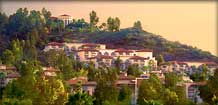|
|

Crafted by renowned golf course architect Gary Panks, the championship design at Trilogy golf club draws upon distinctive land features and a backdrop of stunning Arizona scenery to result in a truly extraordinary setting.
With more than 70 pronounced and transitional bunkers that feed gently into the golf course's fairways and native areas, Trilogy Golf Club at Vistancia highly rewards careful planning and precise execution by the golfer. There are five different tee boxes from which to choose on this unique 18-hole, par 72-championship golf course. Tees range fro 5,573 yards to 7,259 yards, allowing players of every skill level to enjoy this exceptional test of golf.
Trilogy Golf Club at Vistancia is located 25 minutes northwest of Phoenix in Peoria, Arizona. The golf course and clubhouse, featuring fine fare at Verde Grill, are both complementing components of the recreational amenities of the residential resort community developed by Shea Homes.
The Verdict: With only 23 courses in the United States that Golf Digest considers worthy of its prestigious five star designation, only one of those is in Arizona, the Trilogy Golf Club at Vistancia. With a design that is completely unique in Arizona: rolling terrain, striking native grasses, and shot making variety akin to the Midwest’s best courses.

Package Notes:
Prices are per golfer based on 2 persons sharing a two-room suite - includes all taxes. Prices are subject to change without notice. Accommodations and golf are subject to availability.
Course Opened:
2004
Course Type/Style:
Public/Desert
Number of Tee Boxes:
5 sets
Total Number of Sand Bunkers:
70-80
Number of Water Hazards:
4 of 18 holes
Most Challenging Hole:
No. 5
Most Memorable Hole:
No. 18
Sinature Hole:
No. 2
Acreage of Course:
90 acres
Average Size of Greens:
6,400 sq. ft.
Primary Grasses
Fairways:
Bermuda
Rough:
Bermuda
Greens:
Tif Eagle Bermuda
Months Open:
January – December
High Season:
January – April
Aerification:
Overseeding:
October 12-29
Rounds per year:
Green Fees:
Low: $39 High: $130
Walking Options:
Unrestricted Walking
General Manager:
Greg Ellis
Golf Operations Manager:
Joshua Doxtator, PGA
Superintendent:
Roger Brashear, GCSAA
Golf Digest ![]() rating
rating
By Chris King on May 4, 2010
The TPC-Myrtle Beach is one of the Grand Strand's bluebloods.
It enjoys the benefit of a premium brand, superior design (the team of Lanny Wadkins and Tom Fazio is tough to beat), and it's the home course of Dustin Johnson, a three-time winner on the PGA Tour. Throw in a bevy of national honors, and it's not hard to see why the facility is so highly regarded.
Identifying the three best holes on a course that has hosted what was then the Senior PGA Tour Championship and gets a regular workout from Johnson is a challenging task, because the candidates are plentiful. We asked course owner Chip Smith to identify the best of the best at TPC-Myrtle Beach and he complied, with an assist from Johnson.
The three best holes at TPC are:
No. 5, 158-yard, Par 3: Despite being TPC's shortest hole, the fifth is one of its most challenging, particularly from the tips where the tee shot requires a long forced carry over water. The green is wider than it is deep, so your margin for error is limited. A bunker in the right front looms for players not playing from the tips, as does a bunker in back of the green.
"There is almost a false front on the front of the green," Smith said. "It's a tough little shot because the green is narrow. The right side of the green is always better than short because of the lake."
No. 17, 193-yard, par 3: The words island green and TPC have almost become synonymous because of the famed 17th at Sawgrass, and No. 17 at TPC-Myrtle Beach is a reasonable approximation. The primary differences? The 17th in Myrtle Beach is a peninsula green surrounded by water on "only" three sides and it's approximately 50 yards longer. The 17th is TPC-Myrtle Beach's signature hole and with an almost constant wind, it represents a significant challenge. "Because of the distance, I think it's a little tougher than 17 at Sawgrass," Smith says. "Now I've never stood on 17 at Sawgrass on Sunday with $1.4 million on the line either (laugh)."
No. 18, 538-yard, par 5: The 18th, with a creek running along the right side of the fairway and a large lake on the left, is Johnson's choice as the course's best. It's a classic risk-reward hole. Players that can snuggle up to the creek before it runs out to the lake can get home in two, but there is considerable risk. Half of the green is exposed to water and with the rough surrounding it shaved, it's not an easy green to hold. One person who doesn't have to worry about length is Johnson. What does one of the PGA Tour's longest hitters use to reach the green on his second shot? "Depending on which way the wind is blowing, anywhere from a 5 or 6 iron to a 3-wood," he said. For the mere mortals among us, an iron on the second shot when attempting to reach the 18th green is out of the question!